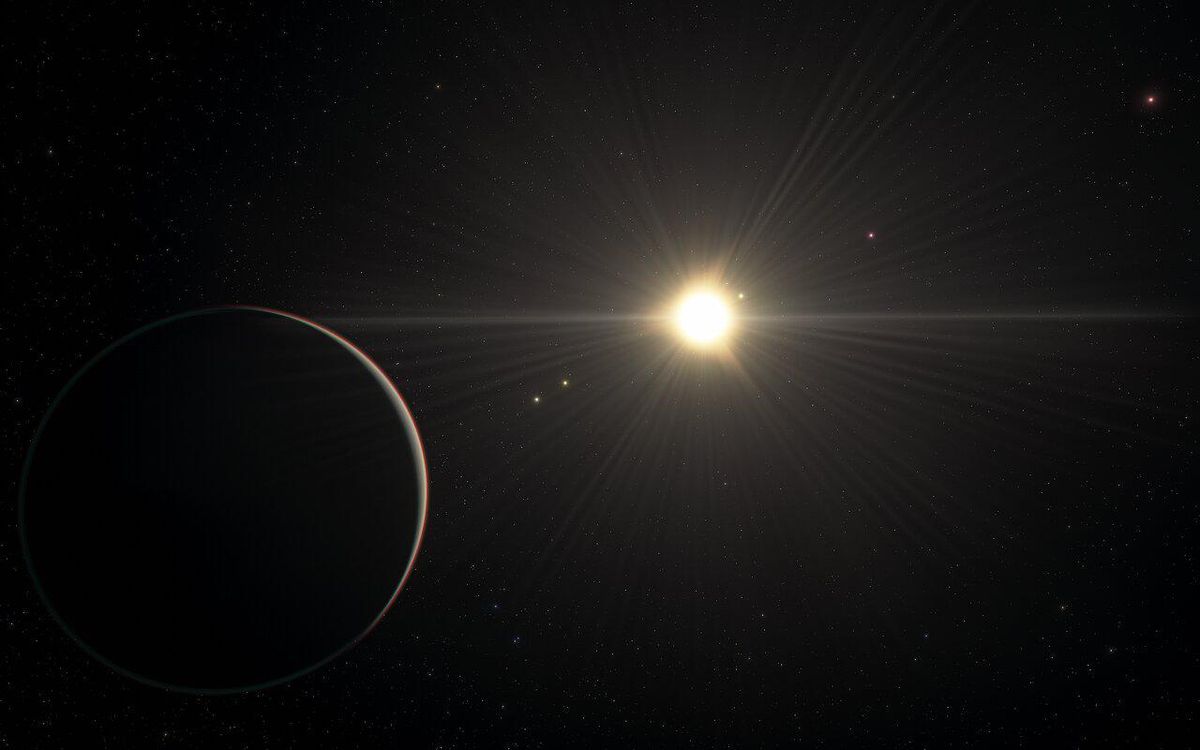This artist’s impression shows the view from the planet in the TOI-178 system found orbiting … [+]
ESO/L. Calçada/spaceengine.org
A bizarre system “singing planets” has been unearthed by astronomers.
The stars system—known as TOI-178, and about 200 light-years from us—features six planets, five of which are locked in a highly unexpected “rhythmic dance” as they move in their orbits.
Described as in resonance, the five planets’ orbits create patterns that repeat themselves, with some of them aligning every few orbits.
The result is a hypnotic rhythm. Have a listen for yourself:
In the video the rhythmic movement of the planets around the central star is represented through a musical harmony, created by attributing a note in the pentatonic scale to each of the planets in the resonance chain.
A note plays when a planet completes either one full orbit or one half orbit, and when planets align at these points in their orbits, they ring in resonance.
TOI-178 is a strange star system indeed; the innermost planet completes an orbit in two days, while the slowest takes 20 days.
The discovery of their resonance is highly unusual in exoplanet research, though there is a similar, far simpler example much closer to home.
The inner three moons of Jupiter—Io, Europa and Ganymede—are locked in a 4:2:1 orbital resonance. Inner-most moon Io orbits Jupiter four times for two that Europa makes, and for every four that Ganymede makes.
That means they play the same note in different octaves. Have a listen for yourself:
However, the planets orbiting the star TOI-178 are in a much more complex chain of resonance. They’re locked in a 18:9:6:4:3 resonance—the longest yet discovered in a system of planets—a level of complexity that adds to their entrancing “song.”
It was only after uncovering the “song” of star system TOI-178 that the astronomers found a sixth planet. They used the resonant rhythm to calculate where in its orbit an additional planet would be when they next had a window to observe the system—then successfully got data on it.
The rare “rhythm dance” in the TOI-178 star system was uncovered using the European Southern Observatory (ESO)’s Very Large Telescope (VLT) in Chile. The paper is published today in Astronomy & Astrophysics.
However, it’s not just an orbital curiosity.
“The orbits in this system are very well ordered, which tells us that this system has evolved quite gently since its birth,” said co-author Yann Alibert from the University of Bern.
What does differ greatly about these six exoplanets is their densities. “It appears there is a planet as dense as the Earth right next to a very fluffy planet with half the density of Neptune, followed by a planet with the density of Neptune,” said Nathan Hara from the Université de Genève, Switzerland, who was also involved in the study. “It is not what we are used to.”
However, as well as telling the astronomers a lot about how the TOI-178 star system formed, it’s believed the system could provide important clues about how planets form and evolve—including those in our Solar System.
“This contrast between the rhythmic harmony of the orbital motion and the disorderly densities certainly challenges our understanding of the formation and evolution of planetary systems,” said Adrien Leleu from the Université de Genève and the University of Bern, Switzerland, who led the study.
This chart shows the location of the planetary system TOI-178 in the constellation of Sculptor. The … [+]
ESO, IAU and Sky & Telescope
The paper even claims that the resonances and variation in densities found in the TOI-178 star system could make it a “Rosetta Stone” in understanding planet formation and evolution.
That could be especially important if the researchers could find any planets in the star’s “habitable zone” where liquid water could exists on their surface. The planets are “Super-Earths”—bigger and more massive—or gaseous “Mini-Neptunes,” and none are in the star’s habitable zone.
It’s hoped that by continuing the resonance chain and by using ESO’s upcoming Extremely Large Telescope (ELT)—due to see “first light” during the mid-2020s—the researchers will be able to find more planets and, what’s more, directly image them.
Wishing you clear skies and wide eyes.
This article is auto-generated by Algorithm Source: www.forbes.com


